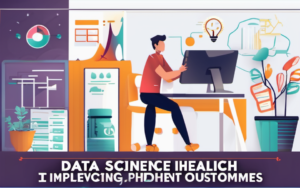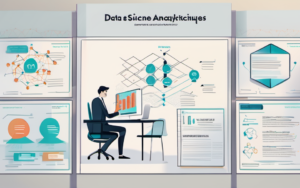The rapid urbanization of the world is driving a demand for more efficient, sustainable, and livable cities. This is where the concept of “smart cities” comes into play. Smart cities leverage technology and data to improve urban infrastructure, services, and quality of life for their citizens. At the heart of this transformation lies data science, playing a pivotal role in shaping the future of our urban environments.
The Rise of Smart Cities
Defining Smart Cities
A smart city is not just a city with advanced technology. It’s a city that uses technology and data to address its challenges and improve its overall performance. Smart cities are characterized by their ability to gather, analyze, and act upon data to optimize various aspects of urban life, from transportation and energy consumption to public safety and citizen engagement.
Key Components of Smart Cities
Smart cities are built on a foundation of interconnected components, each contributing to the overall efficiency and livability of the city. These components include:
- Smart Infrastructure: Intelligent systems for managing transportation, energy, water, and waste.
- Smart Mobility: Real-time traffic management, optimized public transportation, and smart parking solutions.
- Smart Environment: Monitoring and managing air quality, noise pollution, and resource consumption.
- Smart Governance: Efficient citizen services, transparent government operations, and participatory decision-making.
- Smart Security: Advanced surveillance systems, crime prevention strategies, and emergency response systems.
Data Science: The Backbone of Smart Cities
Data Collection and Integration
Data science enables smart cities to collect vast amounts of data from various sources, including sensors, mobile devices, social media, and government databases. This data can include information on traffic patterns, energy consumption, air quality, crime rates, and citizen feedback. Data integration is crucial for creating a comprehensive and unified picture of the city’s operations.
Data Analysis and Insights
Once data is collected and integrated, data scientists use powerful analytical techniques to extract meaningful insights. This involves applying statistical methods, machine learning algorithms, and data visualization tools to identify trends, patterns, and anomalies. These insights provide valuable information for decision-making and problem-solving in various areas of urban management.
Predictive Modeling and Optimization
Data science allows for the development of predictive models that anticipate future trends and optimize resource allocation. For example, by analyzing historical traffic data, smart cities can develop models to predict traffic congestion and optimize traffic flow. This can help reduce travel time, improve fuel efficiency, and reduce greenhouse gas emissions.
Applications of Data Science in Smart Cities
Traffic Management and Optimization
Data science plays a critical role in improving traffic flow and reducing congestion in smart cities. By analyzing real-time traffic data from sensors and GPS devices, cities can identify bottlenecks and adjust traffic signals to optimize traffic flow. This also allows for dynamic route planning, providing drivers with alternative routes and reducing travel time.
Resource Management and Sustainability
Data science can help cities manage their resources more efficiently and promote sustainable practices. By analyzing energy consumption data, cities can identify areas for improvement and implement strategies to reduce energy waste. Similarly, data analysis can help optimize water usage, manage waste disposal, and promote renewable energy sources.
Public Safety and Security
Data science contributes to enhancing public safety and security in smart cities. By analyzing crime data and identifying patterns, cities can deploy resources strategically and develop targeted crime prevention initiatives. Real-time data from surveillance cameras and social media can also be used to respond quickly to emergencies and provide timely assistance.
Citizen Engagement and Services
Data science can improve citizen engagement and service delivery in smart cities. By analyzing citizen feedback and complaints, cities can identify areas for improvement and personalize services based on individual needs. Data-driven insights can also be used to design more efficient and responsive public services, such as healthcare, education, and social welfare.
Challenges and Opportunities
Data Privacy and Security
One of the key challenges facing smart cities is ensuring the privacy and security of the vast amounts of data they collect. Citizens are understandably concerned about the potential misuse of their personal information. Strong data security measures, robust privacy policies, and transparent data governance practices are essential to address these concerns.
Ethical Considerations
As smart cities become increasingly reliant on data, ethical considerations become paramount. It’s crucial to ensure that the use of data is fair, unbiased, and transparent. Data scientists and city officials must be mindful of potential biases in data collection and analysis and work to mitigate any negative impacts on vulnerable populations.
Infrastructure and Technology
Building a truly smart city requires significant investments in infrastructure and technology. This includes deploying sensor networks, upgrading communication networks, and developing robust data analytics platforms. The cost and complexity of these investments can be a barrier for some cities, particularly those with limited resources.
The Future of Smart Cities and Data Science
Emerging Technologies and Trends
The future of smart cities is intertwined with emerging technologies like the Internet of Things (IoT), artificial intelligence (AI), and blockchain. IoT devices will generate even larger volumes of data, providing more granular insights into urban operations. AI and machine learning will enable smarter decision-making and automation of tasks. Blockchain technology can be used to enhance data security, transparency, and trust in smart city systems.
The Role of AI and Machine Learning
AI and machine learning are transforming the way data is analyzed and used in smart cities. AI algorithms can learn from data and make predictions about future events, enabling proactive decision-making and optimization of urban systems. For example, AI can be used to predict traffic congestion, optimize energy consumption, and detect potential security threats.
Building Sustainable and Equitable Cities
The ultimate goal of smart city initiatives is to build sustainable and equitable cities that provide a high quality of life for all residents. By leveraging data science and emerging technologies, cities can address environmental challenges, promote social inclusion, and improve the well-being of their citizens.
The integration of data science into the fabric of smart cities is essential for creating more efficient, resilient, and sustainable urban environments. By harnessing the power of data, cities can overcome challenges, improve services, and build a better future for their residents. As technology continues to evolve, the role of data science in shaping the future of our cities will only become more significant.




